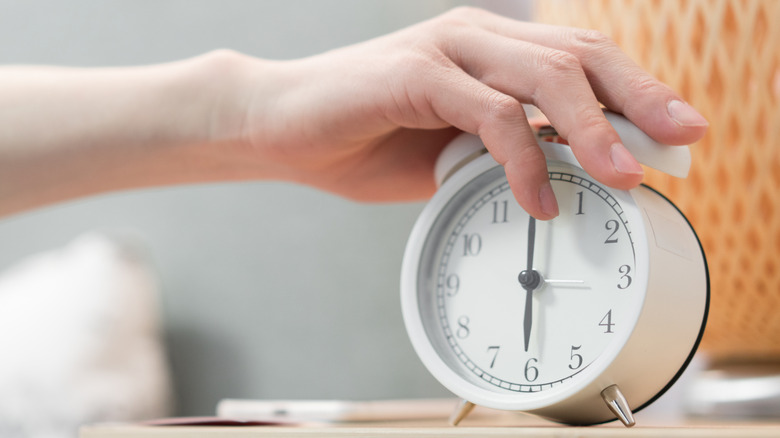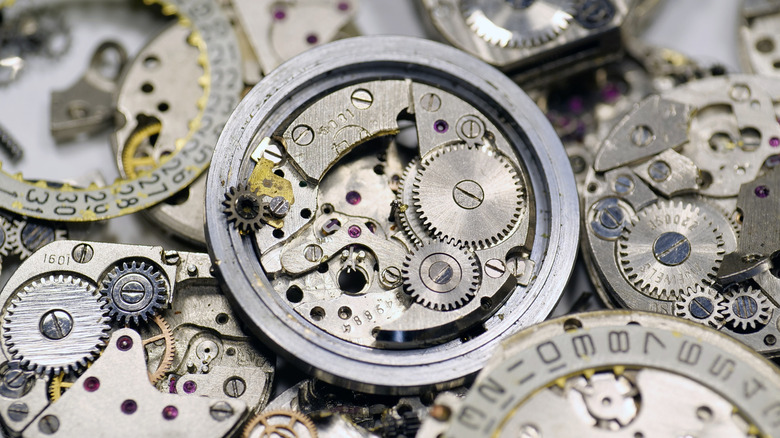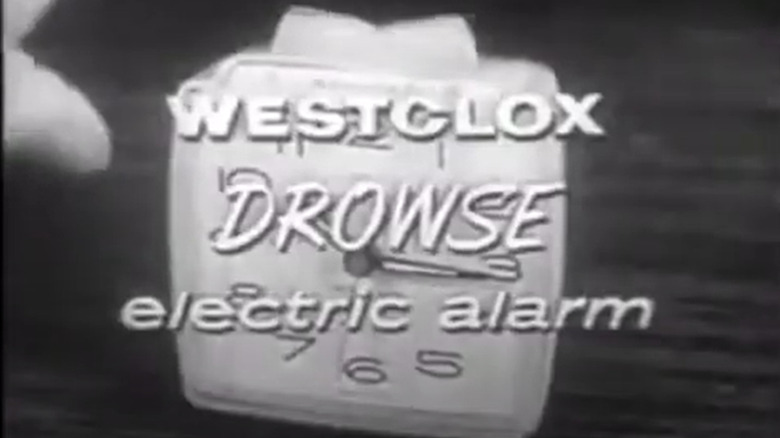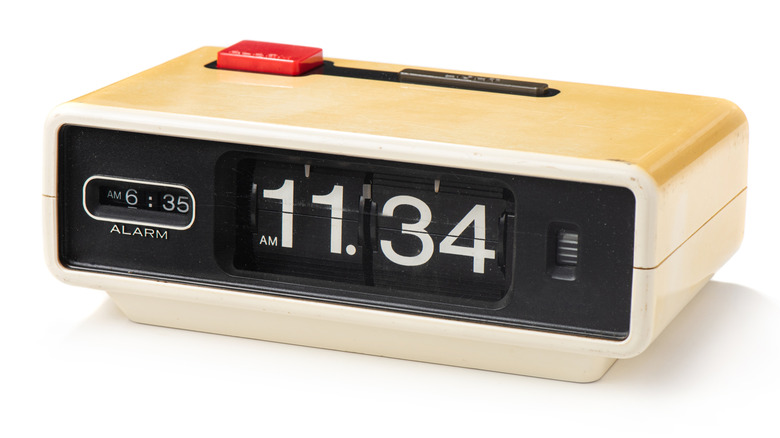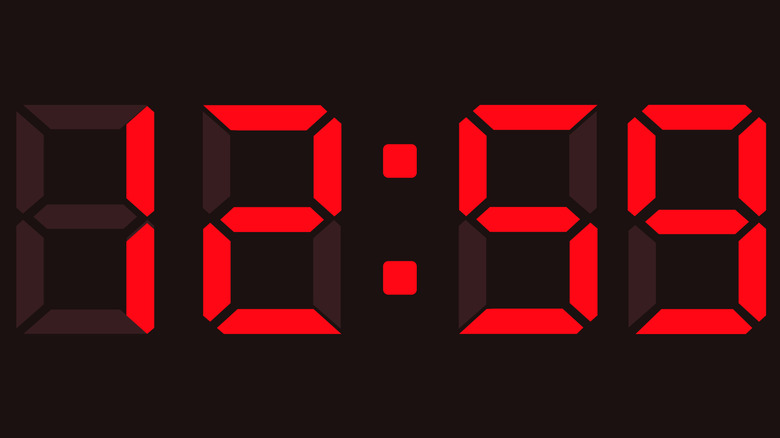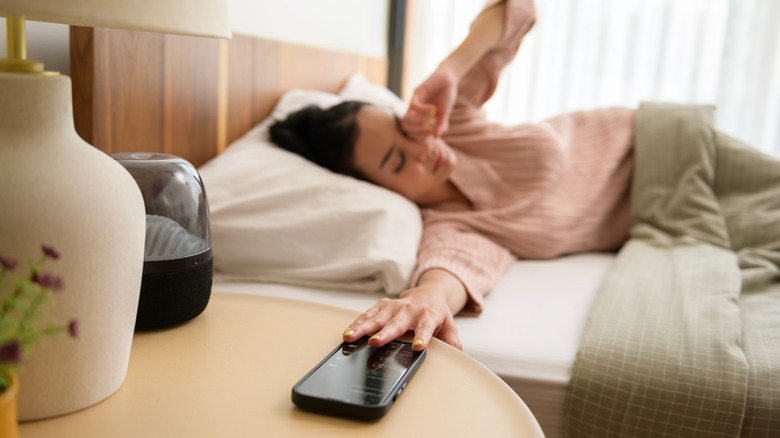Why Is Snooze 9 Minutes? Everyone's Been Getting It Wrong, And Here's Why
Are you someone who hits snooze three times before crawling out of bed — or do you leap up at the first chime, wondering why anyone would want to delay the inevitable? The snooze button is a divisive feature in our daily lives. People have very strong opinions about it. For some, it's a gentle gateway between sleep and wakefulness, a comforting cushion that makes mornings just a little more bearable. For others, it's the ultimate productivity killer, tricking us into fragmented sleep when we're at our most sleepy and vulnerable.
If you're in the pro-snooze camp, then the exact number of minutes you get after hitting the snooze button is pretty important. Many alarm clocks allow you to set your own snooze length, but they all come with a default. If you're from the U.S. – or you're an iPhone user – then you probably reckon that nine minutes is the standard snooze allowance. You may have even set your alarm for nine, 18, or 27 minutes before you actually need to get up so you can fit in a few snoozes before you need to eventually roll out of bed.
Many modern alarm clocks have a nine-minute snooze feature, including iPhone alarms, which have a preset nine-minute snooze time with no option to customize it. This has led many seemingly reputable sources to claim that the nine-minute snooze has a long historical precedent. However, I discovered the history of snoozable alarm clocks tells a different story.
The General Electric-Telechron Snooz-Alarm featured the world's first snooze button
The nine-minute snooze time, according to many explanations, goes all the way back to the first alarm clock with a snooze function. The General Electric-Telechron Snooz-Alarm, marketed as "the world's most humane alarm clock," was first released in 1956. The reason given is that the snooze function needed to be incorporated into a pre-existing clock design, and the size and shape of the gears and levers made it impossible to set the snooze for exactly ten minutes. So, due to the number of teeth on a cog, engineers had to choose between nine and a bit minutes or eleven and a bit minutes. General Electric chose nine, and it henceforth became an international standard.
This isn't true. While the Snooz-Alarm was indeed the first clock to introduce the technological advancement of whacking a button on the top to give you a few extra minutes of shut-eye, there's no evidence that it ever provided nine minutes worth. This original advertisement for the General Electric-Telechron Snooz-Alarm promised "about ten minutes," although other ads in the same year didn't specify a time, and just promised a "luxurious extra 40 winks."
"About ten minutes" was apparently a very rough, ball-park figure. Clock collector and Telechron expert Jay Kennan tested several Snooz-Alarm models and reported on his website that the snooze lasted for about 16 to 17 minutes. Five years after its invention, in 1961, General Electric was still selling alarm clocks with a ten-minute-ish snooze time.
Other early analog alarm clocks didn't have a 9-minute snooze either
Telechron-General Electric may have been the first, but their major competitor, Westclox, soon joined the snooze-buttoned alarm clock game. The Westclox Drowse Alarm clock, released in 1959, had a snooze button that let you choose between five and ten minutes extra sleep, depending on whether you pressed the left or right side. Westclox continued to offer the two snooze length options until the early '80s. Its clocks also came with seven-minute and ten-minute snooze durations.
There may have been other manufacturers of snoozable alarm clocks in the 1950s and 1960s besides General Electric and Westclox, but, if so, it's nearly impossible to find out any details about them. All the listings on sites like eBay with any sort of provenance are made by one or the other. America, apparently, was leading the world in snooze button tech in the mid-twentieth century.
So if nine minutes wasn't a standard for analog alarm clocks in the fifties and sixties, the length clearly has nothing to do with cog sizes. However, many online explanations put the nine-minute snooze time down to limitations of 1970s digital clock tech, so maybe the advent of the digital alarm clock age will shed some light on the matter.
Flip digital clocks were the next big alarm clock innovation
Before there were LED digital alarm clocks, there were flip clocks, which used a system of rotating cards that physically "flipped" to display the time. These electromechanical devices were powered by synchronous motors and relied on precise gear systems. In contrast, the LED clocks that followed in the late 1970s used digital displays. According to some theories, the mechanics of flip-digit displays made it simpler to operate using only the right-hand side column of numbers. Using a two-digit delay time meant using the tens column, and that required extra gearing, so engineers opted for a nine-minute snooze time rather than a ten-minute one.
It sounds plausible, but is let down by the fact that many flip alarm clocks did have a ten-minute snooze function. Clearly, if there was a mechanical limitation, engineers found a way around it. In the 1970s, General Electric sold flip alarm clocks with a ten-minute snooze function. There were shorter snooze options, too. RCA's 1970s flip alarm clock only gave you seven minutes. So if the flip clock didn't herald the nine-minute snooze era, what about its successor, the LED digital alarm clock?
LED digital clocks and the dawn of the 9-minute snooze
LED clocks were introduced in the mid-1970s and became really popular in the 1980s. It turns out that this is the point in alarm clock history where the nine-minute snooze makes its first appearance. Once General Electric started making LED alarm clocks, including their incredibly popular clock radios, they introduced the nine-minute snooze default. The snooze time was adjustable, and you could set it to anywhere between 1 minute and 59 minutes.
Nine minutes was still far from being a universal standard. Even General Electric, which mostly favored nine minutes, released an alarm clock in the 1980s with a ten-minute default. Outside of General Electric, the nine-minute snooze didn't exist at all. The 1980s Spartus Quartz Travel Alarm Clock, for example, had a default snooze time of just four minutes, and one of the earliest digital alarm clocks, made by Texas Instruments in 1974, had a non-adjustable snooze of six to seven minutes.
It seems that at no point in alarm clock history were there technical limitations that created a uniform snooze time. The next iteration of digital alarm clocks uses computer programming, and coding nine, ten, or 9.675574 minutes is obviously no easier or harder than any other number. Yet, ironically, this is when the nine-minute rule actually became a not-quite-universal standard.
The nine-minute snooze is specific to the U.S.
Sometime in the last couple of decades, nine minutes of snoozing time became standard. At least, it did in the U.S.A. I looked at alarm clocks that specified a snooze length on Amazon's U.S. site. Whatever the brand, they all listed nine minutes. However, Amazon sites in the UK, Australia, Japan, and even Canada tell a different story. Canada had a few nine-minute options, but there were also clocks with default snooze times of five and seven minutes. In the UK, Japan, and Australia, the default snooze time most frequently listed was five minutes long.
The U.S. snooze standard seems to be all down to the one company whose digital clocks did come with a nine-minute snooze function. General Electric's alarm clocks were incredibly popular in the United States. This Reddit thread refers to them as the clock that "everyone seemed to have." The ubiquity of these particular clocks apparently cemented the idea in people's heads that all alarm clock snoozes are (or at least should be) set to nine minutes. Other U.S. manufacturers followed suit, and people, assuming that this had always been the case, retrospectively created a part of alarm clock history that never happened. Answering the question "Why do alarm clocks snooze for nine minutes?" with "Well, why not?" didn't satisfy people's need for a definitive answer. They wanted scientific, historical, or psychological explanations. So they made some up.
This all makes Apple's decision to restrict its iPhone alarm to a non-adjustable nine-minute snooze rather annoying. Also, because Apple has customers all over the world, people in other countries may soon start to consider the nine-minute snooze time the norm. They might soon come up with some plausible-sounding, but completely fabricated, reasons why this is.
